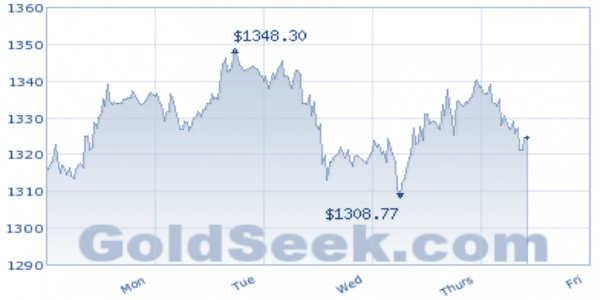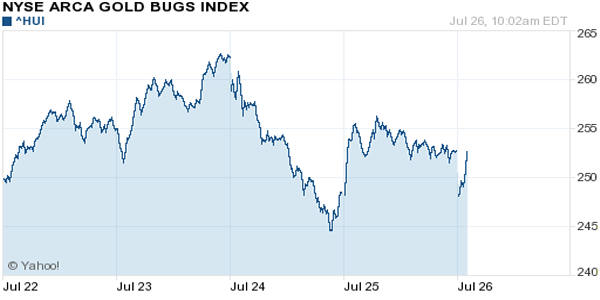What the hedge! – Gold Miners weekly recap
Friday July 26, 2013
Intro
Before diving into the Weekly Recap we present an abbreviated version of our Comparative Analysis Table for your reference and ours. It compares the operations of 12 of the top gold producers as measured by market cap.
It is a sampling of our in-house analysis customized to capture the key metrics of the gold mining business. The complete table, available to subscribers, encompasses a long list of producers and a mountain of painstaking data gathering that we keep updated on a monthly, quarterly and annual basis as the information is released.
(Click the image to enlarge)
The Dreaded Gold Hedge
For this week’s recap we sprint ahead of a news story that is starting slow out of the gates but we think will gain momentum.
The story I am talking about is hedging. To a gold mining investor, when hedging and gold miners are mentioned together, it’s the equivalent to taking the lord’s name in vein while in church.
We get it! Our newsletter is called Gold Miners. We’re gold bulls who like to invest in quality gold mining stocks for the leverage they offer to the gold price. But, before we completely disregard the blasphemous practice let’s briefly go over hedging and then examine the issue as it currently affects gold miners.
The general practice has application to many aspects of mining operations and can be very complex. The purpose is to manage various risks and it can be applied to key factors such as fuel costs, commodity costs related to equipment, and exchange rates.
On the production side of the ledger, under certain conditions, miners will also engage in hedging the production of metals produced as a byproduct of gold (e.g. silver, copper, and zinc). Typically, this takes two forms.
On the one hand, a company might pre-sell its byproduct metal production for a fixed price to finance mine development, which can take the form of a royalty arrangement or metal streaming agreement. On the other hand, an existing producer might hedge the production of byproduct metals to stabilize costs, since the revenue from these sales are recorded as a credit against operating costs.
Putting those hedging examples aside, to make our point this week we want to keep our gold hedging discussion simple and just focus on gold production hedging through the use of what’s known as a forward contract.
Generally speaking, a gold forward is a non-exchange traded and non-standardized contract (as opposed to a standardized futures contract traded on a public exchange) between a gold miner and a gold purchaser in which an amount of gold is delivered at a future date at a pre-determined price.
A gold miner will typically hedge gold in this manner to lock-in a profitable price for future production. This way they can protect themselves from any potential decline in gold price. Of course this has risk as well. By locking-in a price, it means they miss out on the opportunity presented by a rising gold price.
To Hedge Or Not to Hedge, That Be The Question
With this basic concept under our belt, let’s explore how it relates to the current gold mining climate.
As you are undoubtedly aware, the gold price has been falling since the beginning of the year. However, mid-April is when the price fell off the table, dropping US$250 in a week to approximately US$1,350.
Because gold is really heavy, after falling off the table, it fell through the floor and ultimately landed below $1,200 by the end of June. From that time, gold has risen from the basement and currently gyrates uneasily around $1,325.
The current gold price is alarming to major gold miners because it is close to their average ‘all-in’ production cost of $1,350. This means that right now a significant portion of the industry is losing money producing gold.
In contrast, one company that is currently profitable, as you can see in our Comparative Analysis Table above, is Goldcorp.
By our calculation, their average ‘all-in’ cost to produce an ounce of gold is US$1,238, which presently means they are making a profit of $87 per ounce on average. That’s nothing to jump for joy over but that’s more than some of their peers can say!
Recalling the recent price decline to $1,200 from above, Goldcorp doesn’t make money at this price. Since our topic this week is hedging, the question we ask is: what if the unthinkable happens and the gold price falls to $900?
I know what you are thinking… “US$900 gold? Sacrilege!”
Given the evidence we have presented in this column in previous weeks citing historic physical gold demand from Asia, high premiums for physical, and the rapid decline of western COMEX, LBMA and ETF inventories, we don’t think there is a big chance gold is going to US$900.
But, take note, we said big chance, meaning there is some chance, however low, and even Jimmy Rogers said it’s possible so… it’s possible.
So what if? Let’s continue with Goldcorp as an example. Should they hedge some future gold production at today’s price to make sure in the short-term they can cover their costs, keep their mines operating, and the coffee machine running in the office?
There are so many moving parts to this decision we are glad we don’t have to make it!
But as investors, even though we are mid to long-term gold bulls and invest in gold miners for the leverage they provide to a rising gold price, a company has to first survive to the mid or long-term. After all, the gold price could stay low longer than many companies could remain solvent.
Goldcorp’s CFO would have to figure out the real numbers, but for discussions sake let’s consider a scenario. Let’s pretend that they only have to hedge 10% of their gold production for 2 years to guarantee that mines will stay operational and the lights will stay on during that time.
Isn’t sacrificing that 10% worth it for the mid to long-term gold bull who is unsure about the short-term?
This discussion is all about managing risk, which is, after all, management’s job.
This is one reason why focusing on quality management teams when making investments in gold miners is critical. As investors, we want management teams that are bullish on the product they sell; gold, and yet sober-minded and shrewd with regard to the possibility and impact of price declines.
With regard to hedging, management must consider a multitude of factors in determining just how much hedging to employ.
Too much hedging and a company can miss the profits from a rising gold price, as they spend an agonizing period unwinding their hedge book, while locked-in at a lower gold price. Conversely, too little or no hedging could threaten a company’s survival, if an unprofitable gold price persists for a lengthy period.
Since no one has a crystal ball, figuring out the right balance is no easy task. Some management teams are better at this than others, which is why their track record is important.
In our view, an example of one such management team is represented by Bob Quartermain, President and CEO of Pretium Resources. Mr. Quartermain is currently completing a bulk sample program on their high-grade Brucejack gold project located in British Columbia, Canada.
After the completion of this program they will likely build a gold mine, which costs a lot of money. One of the funding options they are considering is debt financing obtained from a merchant bank. To get this financing, Pretium may have to hedge some of their future gold production to guarantee they will be able to pay back the loan.
Is this a bad decision?
In this case it is not because, like most gold mining companies, Pretium’s shares have fallen dramatically with the price of gold. Since Pretium will soon need to finance the Brucejack mine development, issuing shares at their current low price would be terribly dilutive to existing shareholders.
And if there is one thing gold mining investors hate more than hedging its dilution.
So in this case, the decision to hedge could be considered a prudent one made by Pretium management because it represents a decision that generates non-dilutive financing and locks-in some profits to the benefit of shareholders.
This hedging discussion illustrates that although we, as gold mining investors, want to fully participate in the leverage gold miners provide, there are certain situations where hedging makes sense and as investors we need to focus on finding and aligning ourselves with the best management teams to make these tough decisions on our behalf.
Texas Hold’em Gold Miners Style
Analogies are useful when trying to understand a concept. Although the following analogy is not perfect, it will help to illustrate today’s point.
Texas hold’em is a variation of the standard game of poker. To play the game, a player gets two cards dealt face down called hole cards. Then, there are three cards dealt face up in the middle of the poker table that are community cards, otherwise known as the Flop.
After the Flop there are two more community cards dealt called the Turn and the River. Utilizing your hole cards and the five community cards, the best 5-card poker hand wins.
The final aspect of each hand deals with betting. In Texas hold’em, betting occurs after each round of dealing. In each betting round you can choose to check, bet, call or fold.
Now that we have Texas hold’em figured out, let’s proceed with our analogy and combine Texas hold’em with gold miners to help us make some hedging decisions.
To play Gold Miners Texas hold’em, let’s imagine that a gold miner’s hole cards reflect their all-in cost, the community cards represent the gold price, and betting is a hedging decision.
In Texas hold’em, to check in a betting round means you get a free card. Unfortunately, in Gold Miners Texas hold’em nothing is free, you are not allowed to check. For the remaining betting (or hedging) choices a fold is considered a 25% hedge, a call is a 15% hedge and if you decide to bet, it means you don’t hedge at all.
And finally, the last aspect of Gold Miners Texas Hold’em we have to consider is the amount of chips a gold miner is playing with which is represented by the amount of cash a miner has in the bank.
Now we are finally ready to play Gold Miners Texas hold’em and since we have been referencing Goldcorp already we’ll play as if we were them.
As Goldcorp, we start our hand with a lot of chips because we have a lot of cash in the bank.
The dealer now deals and we receive a pair of 10’s, which reflects our all-in cost and is a better than average hand.
The dealer turns over the Flop and it is 6,J,A. This Flop is equivalent to the current gold price of US$1,325.
We now have our first decision to make, should we fold (25% hedge) knowing that with this Flop we don’t have a great hand, call (15% hedge) feeling that our hand is okay but it could get better, or worse with the Turn card, or bet (no hedge) thinking our hand is strong and have enough cash to wait and see what happens down the road.
We decide to bet (no hedge), we want to gamble! The Turn is dealt and it is a 2. That is not a good card for us!
Another decision needs to be made. Our hand has not improved, the flop (gold price) got worse and we spent chips (money) to see what the next card was.
We decide to bet again. We want to see the River and have a good feeling that it is going to be a good card (a higher gold price).
The River is turned over it is a Q. This does not help us! We have now bet on every round and we are very likely to be beaten.
We are now left with significantly less chips, we are destined to get the same hole cards for future hands and the only thing that can save us is a lucky Flop (gold price). Thinking back, as you always do when you lose a marginal poker hand, you probably should have folded (or hedged) earlier.
The example is just a fun illustration that attempts to relate some decisions gold mining management teams are currently facing right now. Just like poker, gold mining is about managing risk and you need to be a good player to effectively manage it.
And when in doubt, follow the advice of Matt Damon from the poker movie, Rounders, “get your money in when you have the best of it and protect it when you don’t.”
Gold Price This Week
Gold had an active and interesting week considering its opening price of $1,296.70 on Sunday night. The price, as I submit this morning, sits at $1,330.50 and will likely close the week with a decent gain.
You can see in the chart below the relatively large trading range for gold this week. Gold hit a high of US$1,348.30 and a low of US$1,308.77.
Gold Mining Shares This Week
There were significant movements in the gold mining shares this week. Obviously the major stories regarding the shares were the $1.96 and $2.1 billion write-downs taken by Goldcorp and Newmont respectively.
Early on in the week the miners were strong but they gave back all of their weekly gains and more on Wednesday. That being said, it seems as though the shares may improve just a little, but essentially will end flat this week.
Below is the visual for the week.
That’s our recap for this week. If you like Texas hold’em poker check out our website (address below), where Goldcorp makes Final Table at the Gold Miners Poker Tournament.
RJ Wilcox: I am a contributing editor to the Gold Miners Investment Newsletter, a monthly publication focused on mid to large-cap publicly traded gold mining companies. At Gold Miners, I’m helping keep tabs on the passing parade in gold, gold markets, and the gold mining industry.
{{ commodity.name }}
{{ post.title }}
{{ post.date }}





Comments